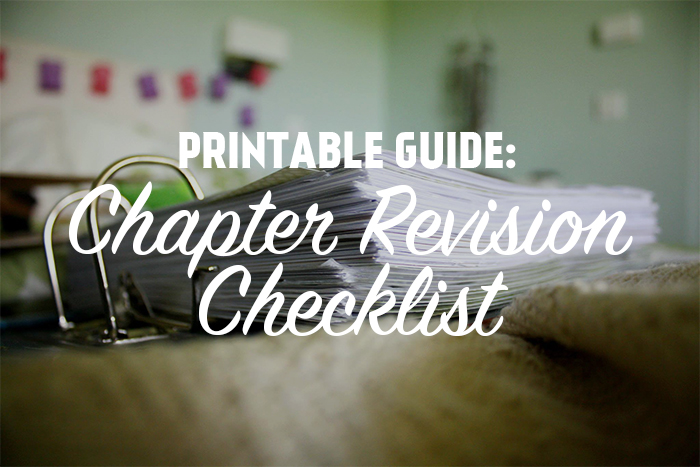You’ve finished your first or second draft. Huzzah! Your plot is fairly intact, your characters’ arcs are in order, and you’re ready to begin revising hardcore.
At this point, I like to pull out my friend the chapter revision checklist. After years of revising, trying not to forget any key elements, I finally sat down and put this together. Now whenever I pull out my pens and start tearing into chapters, I have this beside me to make sure I have my bases covered.

Click the picture to get the full size. Or click here for a print-friendly black and white version.
Before You Begin Revision:
1. Write out the reason this chapter is necessary.
Because, let’s face it, is the chapter necessary? Sometimes in the heat of drafting, you’ll wander off on a bunny trail and end up with a chapter that doesn’t really do much. Or perhaps something does happen, but not until the last page. This is the time where you take a look at what needs to stay, and what maybe belongs somewhere else (like a trashcan, perhaps).
2. Note each character’s stakes.
Every character in every chapter has to have stakes, or it’s not interesting. (Potential exception: redshirts and extras.) Your characters must always be at risk of losing something. Without a threat, there is no conflict, and without conflict there is no tension, and without tension your readers might as well be watching The Fantastic Four. (Burrrrrrn.)
My formula for stakes is simple: If [FILL IN THE BLANK] happens, then [FILL IN THE BLANK].
If Galvin tells the truth, then he will be hanged.
If Romeo and Juliet’s families find out they’re in love, they will be separated forever.
If Eve listens to the snake/Adam eats the apple, then all of humanity will be screwed.
You get the idea. The reason to write this out is so that you can focus in on that core tension as you revise. If you don’t know what your character(s) is/are at risk of losing, your reader won’t either.
Then:
1. Check the first sentence hook.
Does your chapter’s first sentence draw in the reader? Would someone who was thinking about setting the book down keep reading when they see this opening?
Good hooks normally do one or more of these things: Capitalize on a dramatic moment, showcase character voice, create humor, or highlight a contradiction. This blog entry has some good examples. While it’s especially important that the first sentence of the book have a great hook, each chapter needs to open strong to pull your reader further in.
The hook should leave a reader with questions that will keep them going. What’s going to happen next? Why is she doing that? How did the pencil start talking? That sort of thing.
2. Make sure the chapter starts where it should.
Where does the action or heart of your chapter pick up? If the answer is page three, then you have some cutting to do. I find this is frequently the case if I have a character waking up or moving from one place to another (walking to a room, etc.). Trim the fat and stay close to the action.
3. Find chapter theme and use it.
In some ways, chapters should function like short stories. The most satisfying chapters often have their own little arcs (something happens, there is an escalation, there is a sense of resolution (even if it leaves us with more questions than before)). A theme can unify seemingly scattered events and give a chapter shape.
Another way you can think of it is by imagining the chapter as a TV episode. One of my all-time favorite episodes is LOST 4×05: The Constant. Though the main character of the episode is experiencing time displacement (basically time travel) and a lot of crazy other things are going on, the unifying theme of love pulls all the pieces together to an ultimately rewarding end. Don’t underestimate the power of theme.
4. Keep an eye on amplification.
If something repeats in a scene or chapter, make sure that it escalates to new tension every time. For instance, if a character runs away from conflict on the first page and again on page four, something different needs to happen the second time he does it.
If it doesn’t build, it’s repetitive, and one of the instances needs to be cut.
5. Watch for anything that could be cut or trimmed.
Aside from big chunks that you’re hopefully already looking for after our pre-game prep, you should also be on the look out for any potential smaller cuts. Normally I try to cut at least twelve words on every page. (I end up cutting a lot more than that more of the time, but I’m also a wordy writer.)
6. Use vivid description.
Are you using cool details when you describe stuff, or are you resorting to generic language–like saying “stuff”? While everything in a scene does not need to be described in painful detail, you should give thought to a few specifics that can be highlighted (the click of ladies’ pattens on the stone streets / the delicately carved mermaids on a chair / the moon’s phases tattooed around his ear) to make your scene vivid and interesting.
7. Clarify choreography.
Action is hard. Someone famous once said that writing the movement of a character walking to a window is harder than anything else. Choreography has to be clear, concise, and clear. Really clear.
Make sure the movements in your scene are 1) Necessary and 2) Easy to understand.
8. Emphasize character voice.
Your narrator’s voice needs to be coming through loud and clear, whether this is first person or third person. So edit with an eye on voice. Make sure the words choices, point of view, and observations all fit with the character who’s talking.
For you nerds/anyone wanting a few examples, check out my analysis of character voice in Mark of Athena (which also has some case studies of chapter hooks).
9. Cut passive voice.
Passive voice can kill your action. If you are a chronic user (like me), definitely save a read-through strictly for searching out and eliminating passive voice. I normally cheat and highlight common passive voice words to catch it.
10. Make sure the chapter ends where it should.
See Point #2. Sometimes I find that my chapter ends a few lines (or pages) later than it should. Make sure that you’re dropping the scene’s curtain before your readers get bored.
11. Check the last sentence hook.
Once again, you want to be sure that your reader will go straight to the next chapter. End with a bang. Car explosions! Unexpected pregnancy! You know the deal.
What do you do to revise your chapters? Leave a comment below!


















